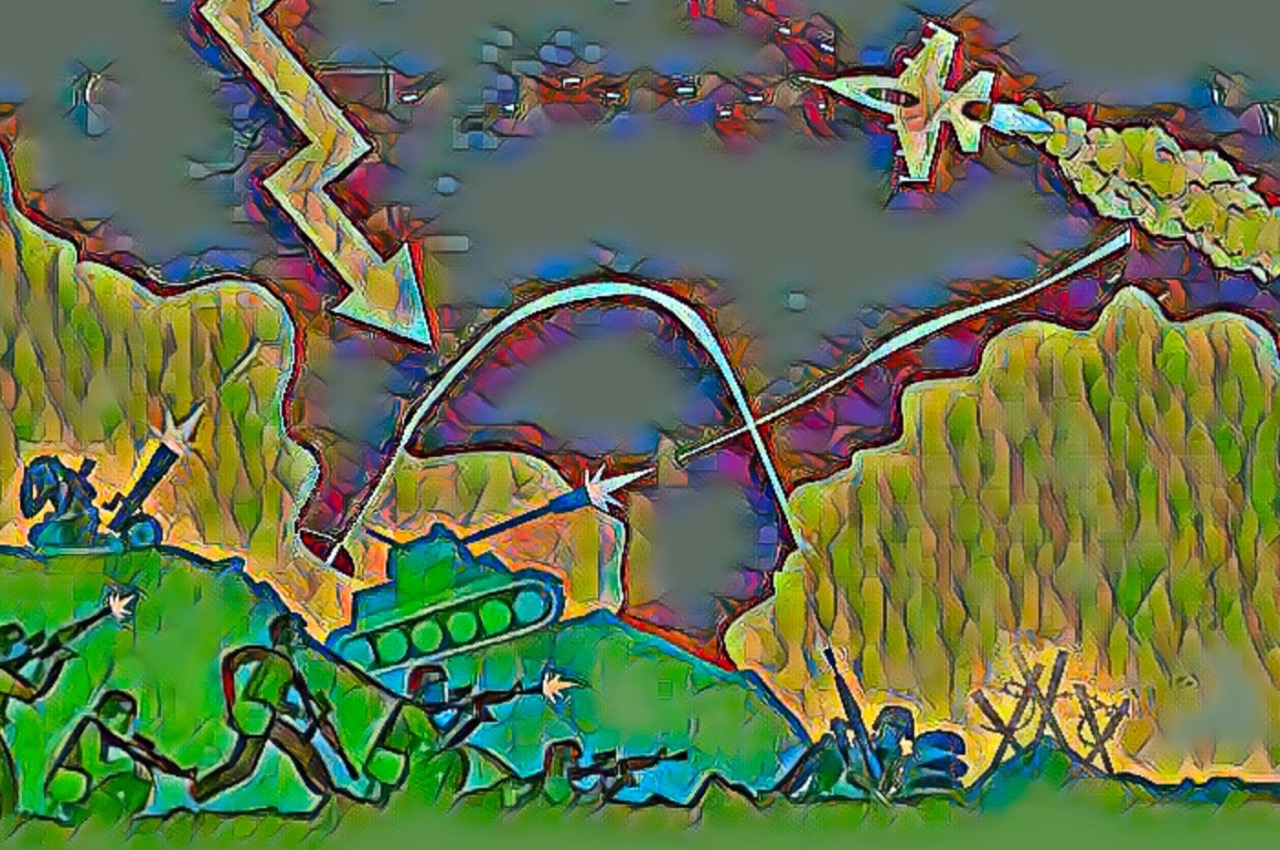Distant drums, local tremors: The price South Asia or any other region pay for faraway wars in a globalized economy

The global landscape feels acutely fragile. A disquieting hum of war drums and the distant thud of missiles resonate across continents.
Nations, armed with terrifying arsenals, including nuclear weapons, seem increasingly ensnared in a dangerous ballet of brinkmanship and muscle-flexing.
While we, as Bangladeshi people, may prefer to imagine ourselves insulated from such conflicts, the unsettling truth is stark: should hostilities erupt in our vicinity, the fallout will undoubtedly reach our shores.
The recent aerial skirmishes over Kashmir between India and Pakistan, coupled with the rapidly intensifying confrontation between Iran and Israel, have cast a long shadow of unease.
Ordinary citizens universally abhor war. This has always been our stance. Yet, these flashpoints force a troubling question to the surface: had these situations spiraled out of control, would we–Bangladesh, and indeed all of South Asia–have been truly ready for the consequences?
The year 2025 witnessed two of the world's most volatile regions–South Asia and the Middle East–teeter on the precipice of full-scale war.
What initially appeared to be familiar flare-ups along old fault lines quickly escalated into something far more alarming. As the lingering smoke still hangs over Kashmir and Tehran, the global order feels more precarious than it has in decades.
Back in May, India and Pakistan found themselves locked in the fiercest high-altitude combat over Kashmir in years, a chilling reminder of the volatility between the two nuclear-armed neighbors.
Rafale jets tore across the Line of Control, missiles reportedly pounded militant hideouts, and the skies bristled with drones and counterstrikes. India asserted it struck insurgent bases, while Pakistan retaliated with its array of F-16s, JF-17s, and the newer J-10C fighters.
The fog of war rapidly descended, shrouding the true extent of casualties in dispute. Yet, the message from both sides was chillingly clear: a single misstep, one errant missile, could unleash catastrophe.
A fragile ceasefire, hastily brokered by over 30 nations, has momentarily silenced the gunfire. But the pause is precisely that–a pause. The wound remains open, the deep-seated tensions stubbornly unresolved.
Then, barely a month later, the storm shifted westward.

The turbulent
Middle East
On June 13, Israel abandoned all pretense of deniability, launching "Operation Rising Lion"--a direct, high-impact assault on Tehran itself.
The era of shadow wars and proxy conflicts was set aside. Israeli fighter jets struck at the heart of Iran’s nuclear program: centrifuge production sites in Karaj, research labs in the capital, and even suspected command centers.
The International Atomic Energy Agency (IAEA) later confirmed what many had feared: Iran’s nuclear infrastructure had sustained heavy damage.
Tehran's response was swift and furious. Within hours, "Operation True Promise III" unleashed waves of hypersonic Fattah missiles and combat drones, piercing through Israel’s vaunted Iron Dome. Beersheba, in the south, bore the brutal brunt.
Civilian buildings crumbled, entire neighborhoods vanished, and over 1,300 people sought emergency shelter in hotels. More than 18,000 damage claims have since been filed.
Life in Israel has not witnessed such devastation, not even during the worst phases of the Gaza wars.
As the fighting intensified, the political temperature soared, revealing the dangerous fragility of global stability. Israel’s defense minister, in a startling escalation, claimed the Iranian regime was on the brink, even drawing parallels between Ayatollah Khamenei and Saddam Hussein.
Across the Atlantic, Donald Trump, once again a prominent voice in global affairs, reinserted himself by demanding Iran’s “unconditional surrender” and urging civilians to flee Tehran.
Iranian officials, in turn, accused Washington of sabotaging ongoing peace talks and effectively greenlighting Israeli aggression.
Then came a chilling illustration of this diplomatic breakdown: the so-called ceasefire, announced not through traditional diplomatic channels, but unilaterally by Trump on Truth Social.
He proclaimed a three-phase truce: Iran would cease firing at 04:00 GMT, Israel would follow twelve hours later, and by day's end, the war would be over.
But reality quickly exposed the dangerous disconnect. Missiles continued to fly. Civilians perished in Beersheba even after Trump’s proclaimed deadline. Iran expanded the battlefield, launching attacks on U.S. military bases in Qatar and Iraq.
Israel retaliated once more. Despite Trump's insistence that the ceasefire had begun, neither Tehran nor Tel Aviv corroborated his claims. Iran’s foreign minister explicitly stated there was no formal deal, only a conditional promise to halt attacks if Israel initiated a ceasefire first.
Meanwhile, airports across the Middle East shut down, a stark visual of the spreading crisis. NATO leaders, gathered in The Hague for a summit, appeared visibly uneasy but remained diplomatically silent, while Trump arrived in the Netherlands, leaving a trail of geopolitical explosions in his wake.
Back in Tehran, another nuclear scientist was reportedly assassinated in a drone strike. The war did not end; it only deepened.
This wasn't merely a failed ceasefire. It was a profound collapse of credibility, a stark signal that even the illusion of diplomacy is wearing perilously thin.
And that, perhaps, is the deeper worry.
Because what is unfolding in Kashmir and Tehran transcends mere territorial disputes or ideological clashes.
It's about the devastating consequences when global diplomacy collapses and the grim logic of war fills the vacuum. These crises didn’t erupt overnight; they are the culmination of years of betrayal, entrenched mistrust, and a growing, dangerous conviction that force—not negotiation—is the only language left.
Now, it is the civilians who bear the unbearable cost. Farmers in Kashmir, families in Tehran, children in Haifa—all are caught in wars they did not instigate, with no discernible end in sight.
Bangladesh, a country which is being run by the motto “friendship to all and malice to none” also can’t stay insulated from these faraway wars.

Bangladesh
amidst this fractured peace and truth
The South Asian nation, while historically under-resourced in defense, has demonstrated steady progress, climbing to 37th in the GFP rankings, a notable improvement from its 40th position in 2024.
With around 160,000 active personnel, the nation maintains a substantial ground force, including 320 tanks, roughly 13,100 armored vehicles, 437 towed artillery units, and 71 multiple-launch rocket systems. Its naval capabilities feature seven frigates, six corvettes, two submarines, and over 50 patrol boats.
In the air, Bangladesh operates 44 fighter jets and a modest helicopter fleet comprising Mi-17s, Mi-171Shs, and AW139s.
However, a clear disparity emerges when comparing Bangladesh's military development to that of regional heavyweights like India, Pakistan, and Iran.
These nations have heavily invested in sophisticated missile and UAV programs, with India leading the region with its formidable long-range Agni missile series. Bangladesh, by contrast, is still in the nascent stages of developing such advanced capabilities, primarily focusing on building foundational defense systems.
Its current air defense network relies on systems such as the FM-90, QW-18 MANPADS, and VT-1 guns, supported by radar technologies sourced from a diverse mix of Chinese, American, Russian, and German suppliers.
Despite these gaps, a significant shift is underway. Under the ambitious "Forces Goal 2030" modernization roadmap, Bangladesh has set its sights on acquiring advanced fighter jets, including potential candidates like the Eurofighter Typhoon, Rafale, or Su-30SME.
The plan also includes integrating airborne early warning and control (AEW&C) systems and expanding its UAV capabilities.
A tangible step in this direction is the government’s Tk380 crore project to overhaul 12 MiG-29 engines by FY2028–a clear signal that the country is taking deliberate, methodical steps toward greater self-reliance and comprehensive defense modernization in an increasingly complex and volatile geopolitical landscape.
But when bombs fall in Tehran or jets engage in dogfights over Kashmir, the shock waves do not conveniently stop at any border. They rattle shopfronts in Karachi, unsettle traders in Dhaka, and keep every South Asian finance minister awake at night.
The notion of insulated economies in a globally interconnected world is a dangerous myth, especially for a region as strategically vital and economically vulnerable as ours.
Former central-bank chief Salehuddin Ahmed has already sounded a stark alarm: if the Iran-Israel conflict drags on, Dhaka’s crucial fuel lifeline from the Gulf could kink overnight.
Brent crude prices have nudged past $74 a barrel since Israel’s June 13 strike, and every additional dollar at the pump shows up at village markets a few weeks later—translating directly into pricier transport, costlier food, and higher inflation that disproportionately impacts ordinary citizens.
Fertilizer is the next domino. The vast majority of it sails through the Strait of Hormuz, a vital waterway that Iran can squeeze any time it feels cornered.
Block that critical chokepoint, and farmers from Multan to Mymensingh will bear the brunt, just as they did when the Russia-Ukraine war sent global prices through the roof in 2022.
The ripple effect of such disruptions is immediate and devastating for agricultural economies reliant on these crucial imports.
Meanwhile, January’s aerial skirmishes over Kashmir sent a shiver through investor confidence across the entire region. In Dhaka, the stock index slid nearly 150 points in a single day; Pakistan’s vital trade corridors also felt the tremor.
Our factories and tech parks operate on the bedrock of predictable logistics. Missing even a week of cross-border shipments can lead to slipped export deadlines, disgruntled international buyers, and, most critically, jobs hanging in the balance for millions.
None of this is mere theory. Insurance premiums on Gulf shipping routes are already steadily inching upward, supply-chain managers are meticulously drawing up new contingency maps, and long-term energy contracts are being red-lined for "force majeure" clauses.
A missile launched in the Gulf now translates, within weeks, into a higher bus fare or a thinner pay packet for families across South Asia.
The distance between someone else’s war and our own wallets has never been shorter. South Asia will only successfully navigate the next storm if its governments act early, build robust buffers, and—crucially—work together.
History continues to hand us stark warnings. It is entirely up to us to transform them into a comprehensive, actionable plan.
—
Nafew Sajed Joy is a Bangladeshi researcher, writer, and environmentalist with a keen focus on sustainable development, social transformation, and the impact of the Fourth and Fifth Industrial Revolutions.

